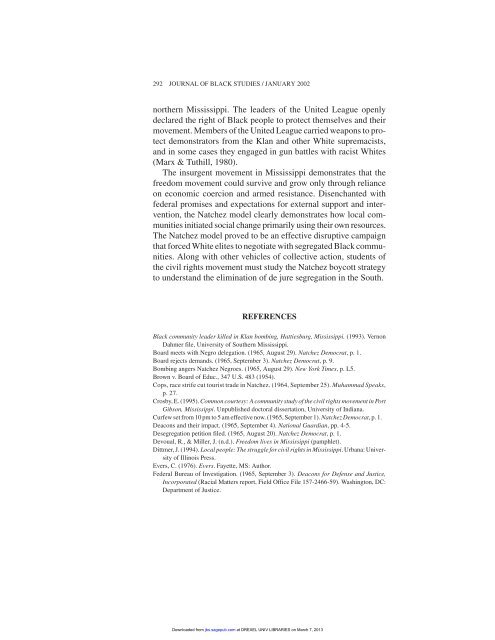MXGM Self-Defence Manual
MXGM Self-Defence Manual
MXGM Self-Defence Manual
You also want an ePaper? Increase the reach of your titles
YUMPU automatically turns print PDFs into web optimized ePapers that Google loves.
292 JOURNAL OF BLACK STUDIES / JANUARY 2002<br />
northern Mississippi. The leaders of the United League openly<br />
declared the right of Black people to protect themselves and their<br />
movement. Members of the United League carried weapons to protect<br />
demonstrators from the Klan and other White supremacists,<br />
and in some cases they engaged in gun battles with racist Whites<br />
(Marx & Tuthill, 1980).<br />
The insurgent movement in Mississippi demonstrates that the<br />
freedom movement could survive and grow only through reliance<br />
on economic coercion and armed resistance. Disenchanted with<br />
federal promises and expectations for external support and intervention,<br />
the Natchez model clearly demonstrates how local communities<br />
initiated social change primarily using their own resources.<br />
The Natchez model proved to be an effective disruptive campaign<br />
that forced White elites to negotiate with segregated Black communities.<br />
Along with other vehicles of collective action, students of<br />
the civil rights movement must study the Natchez boycott strategy<br />
to understand the elimination of de jure segregation in the South.<br />
REFERENCES<br />
Black community leader killed in Klan bombing, Hattiesburg, Mississippi. (1993). Vernon<br />
Dahmer file, University of Southern Mississippi.<br />
Board meets with Negro delegation. (1965, August 29). Natchez Democrat, p. 1.<br />
Board rejects demands. (1965, September 3). Natchez Democrat, p. 9.<br />
Bombing angers Natchez Negroes. (1965, August 29). New York Times, p. L5.<br />
Brown v. Board of Educ., 347 U.S. 483 (1954).<br />
Cops, race strife cut tourist trade in Natchez. (1964, September 25). Muhammad Speaks,<br />
p. 27.<br />
Crosby, E. (1995). Common courtesy: A community study of the civil rights movement in Port<br />
Gibson, Mississippi. Unpublished doctoral dissertation, University of Indiana.<br />
Curfew set from 10 pm to 5 am effective now. (1965, September 1). Natchez Democrat,p.1.<br />
Deacons and their impact. (1965, September 4). National Guardian, pp. 4-5.<br />
Desegregation petition filed. (1965, August 20). Natchez Democrat, p. 1.<br />
Devoual, R., & Miller, J. (n.d.). Freedom lives in Mississippi (pamphlet).<br />
Dittmer, J. (1994). Local people: The struggle for civil rights in Mississippi. Urbana: University<br />
of Illinois Press.<br />
Evers, C. (1976). Evers. Fayette, MS: Author.<br />
Federal Bureau of Investigation. (1965, September 3). Deacons for Defense and Justice,<br />
Incorporated (Racial Matters report, Field Office File 157-2466-59). Washington, DC:<br />
Department of Justice.<br />
Downloaded from jbs.sagepub.com at DREXEL UNIV LIBRARIES on March 7, 2013


